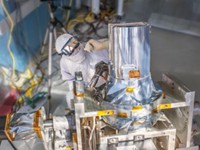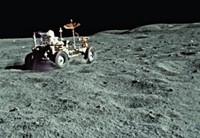Advertisement
Grab your lab coat. Let's get started
Welcome!
Welcome!
Create an account below to get 6 C&EN articles per month, receive newsletters and more - all free.
It seems this is your first time logging in online. Please enter the following information to continue.
As an ACS member you automatically get access to this site. All we need is few more details to create your reading experience.
Not you? Sign in with a different account.
Not you? Sign in with a different account.
ERROR 1
ERROR 1
ERROR 2
ERROR 2
ERROR 2
ERROR 2
ERROR 2
Password and Confirm password must match.
If you have an ACS member number, please enter it here so we can link this account to your membership. (optional)
ERROR 2
ACS values your privacy. By submitting your information, you are gaining access to C&EN and subscribing to our weekly newsletter. We use the information you provide to make your reading experience better, and we will never sell your data to third party members.
Environment
Observing Earth Via Satellite
Continued funding constraints will impede earth science studies
by Bette Hileman
January 22, 2007
| A version of this story appeared in
Volume 85, Issue 4

The U.S. government needs to fund 17 new Earth-observing satellite missions over the next decade, says a two-year study from the National Research Council. Without increased funding for such missions, the report warns, critical data on climate change, hurricanes, winds, polar ice, and shifting patterns of drought and rainfall will not be available.
Prepared by a panel of more than 100 earth scientists, the NRC report sets priorities for the next decade for Earth observation projects at NASA and the National Oceanic & Atmospheric Administration (NOAA).
"At a time when it's never been more important to observe and understand the Earth in all its aspects and to apply this understanding for the benefit of society, the number of Earth-observing instruments on NASA satellites will fall 40% by 2010 unless something is done to reverse the trend," says report cochair Richard A. Anthes, president of the University Corporation for Atmospheric Research. "The general investments in earth science observations are declining at a time when these observations of the planet—the only planet we know of that supports life—are needed more than ever."
The report recommends an annual budget of about $3 billion for satellite measurements and associated data analysis and processing. NASA should get about $2 billion, and a little more than $1 billion should go to NOAA. "Five years ago, NASA's budget for satellite measurements and analysis was about $2 billion a year in 2006 dollars, but since then, it has dropped about 30%," Anthes says.
"A $10-per-capita investment in such observations will repay itself many times over by improving weather forecasts, energy and water resources management, aircraft routing, and hurricane preparedness," Anthes explains. Without such an investment, there will be insufficient data to feed climate models, he warns. "It is important to understand what climate change will do to oceans, fisheries, energy demand, and water supplies."
In preparing the report, researchers from a wide variety of earth science disciplines-geologists, oceanographers, and atmospheric scientists, for example-recommended a set of missions that would, in many cases, collect data for more than one discipline and would constitute a minimal, but robust, observational system, Anthes says. "It is the first time the entire earth science community has gotten together and done anything like this."
"As soon as NASA announced manned travel to the moon and Mars as goals, people recognized that that's where the money would be going, and there wasn't likely to be enough to fully fund a third priority—Earth-observing systems," says Nobel Laureate F. Sherwood Rowland, an atmospheric scientist at the University of California, Irvine. It is very important to maintain continuity in satellite observations, he adds, because if one satellite stops measuring a particular parameter and another begins gathering similar data a few years later, it is hard to intercalibrate between measurements.
President George W. Bush's science adviser, John H. Marburger III, however, claims the Administration is committed to supporting Earth observations and considers them "a top science priority."
But the NRC report is attracting attention in Congress. "At a time when accurate weather forecasting and climate research are becoming increasingly important to the well-being of our citizens, this distinguished panel of experts is warning in no uncertain terms that the U.S.'s extraordinary foundation of global observations is at great risk," says House Science & Technology Committee Chairman Bart Gordon (D-Tenn.). "That finding is no surprise to those of us who have watched the cuts made to NASA's earth science program over the past six years."




Join the conversation
Contact the reporter
Submit a Letter to the Editor for publication
Engage with us on Twitter